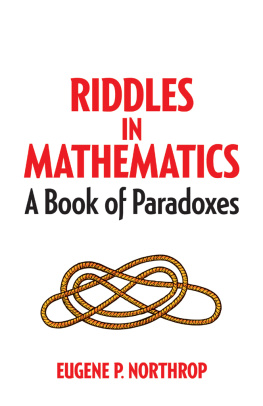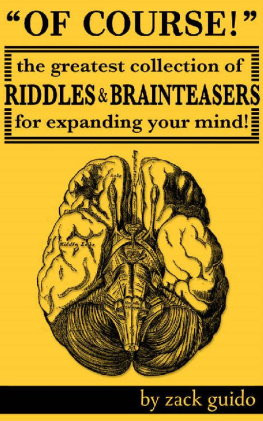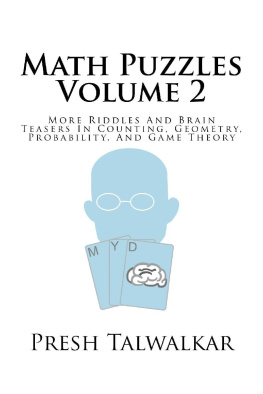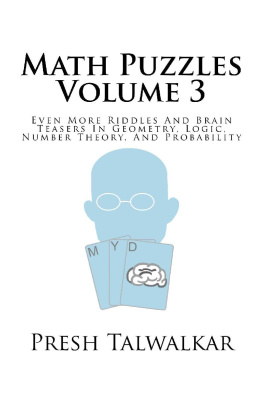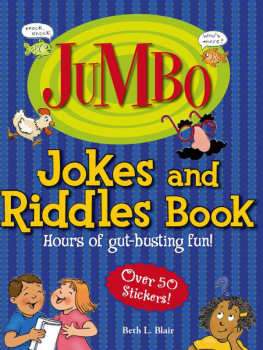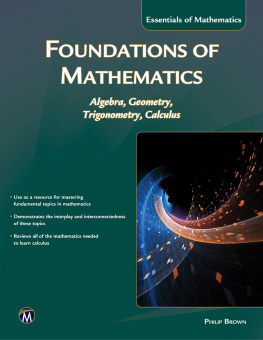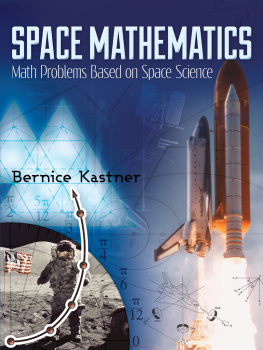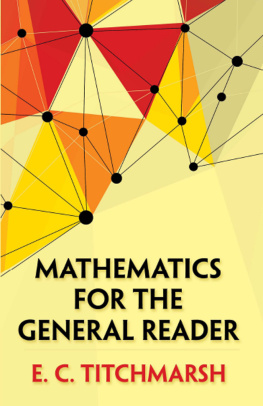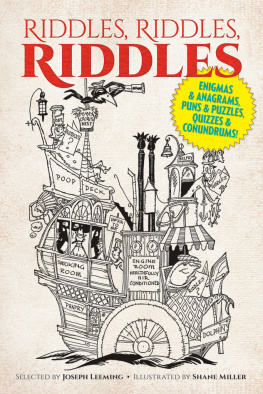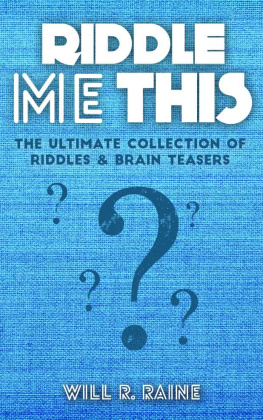www.doverpublications.com
RIDDLES IN MATHEMATICS
A Book of Paradoxes
Eugene P. Northrop
Introduction by
Daniel S. Silver
Dover Publications, Inc.
Mineola, New York
Copyright
Copyright 1944 by Eugene P. Northrop
Copyright Renewed 1972 by Marion L. Northrop
Introduction to the Dover edition Copyright 2014 by Daniel S. Silver
All rights reserved.
Bibliographical Note
This Dover edition, first published in 2014, is an unabridged republication of the work originally published in 1944 by D. Van Nostrand Company, Inc., Princeton, New Jersey. It includes a new Introduction by Daniel S. Silver
International Standard Book Number
eISBN-13: 978-0-486-79500-3
Manufactured in the United States by Courier Corporation
78016301 2014
www.doverpublications.com
To
B. U. N.
Introduction to the Dover Edition
A frog is at the bottom of a 30-foot well. Is it the beginning of a joke? There might be a princess down there too. But the story continues: Each hour he climbs 3 feet and slips back 2. How many hours does it take to get out?
A mathematical riddle is much like a joke. Finding the answer requires us to look at things from more than one perspective. (It does not take the frog 30 hours to get out. Can you find the correct answer?) And as with a joke, our sudden understanding might cause us to laugh.
The book before you is a treasury of mathematical riddles. Some are classics. (Brothers and sisters have I none, but that mans father is my fathers son. What is the relation of that man to the speaker?) Others might be less familiar. (Two points are chosen at random on the surface of a sphere. What is the probability that the distance between them is less than 10 minutes of an arc?) But, like a great joke, a classic riddle is always a pleasure to hear when told by a master.
The subtitle of Riddles in Mathematics is A Book of Paradoxes. What is a paradox? The author, Eugene Northrop, anticipates our question and responds in the first few pages. A paradox is anything which offhand appears to be false but is actually true; or which appears to be true, but is actually false; or which is simply self-contradictory. He writes: From time to time it may appear that we are straying from this meaning. But be patient-what seems crystal-clear to you may leave the next person completely confused. The ability to make things crystal-clear was the authors talent.
Like the author, most mathematicians appreciate good paradoxes. Without the temporary confusion that they create, no new understanding is possible. Put differently, a paradox helps us correct our thinking. It flushes from our minds flawed intuition and hazardous mental debris. Physicist Richard Feynmann expressed it another way: A paradox is not a conflict within reality. It is a conflict between reality and your feeling of what reality should be like.
Paradoxes are not new in mathematics. In the seventeenth century, Galileo Galilei pondered his discovery that squared integers 1, 4, 9, 16,... can be put into one-to-one correspondence with the larger set of natural numbers 1, 2, 3, 4,... which contains them. It was not the only paradox of the infinite that he observed and wrote about in Dialogues Concerning the Two New Sciences. By imagining the hub and rim of a wheel shrinking in area simultaneously Galileo came to the disturbing conclusion that a single point is equal to the circumference of a circle. Northrop sorts out Galileos confusion (alas, three centuries too late to help the Renaissance scholar) and then proceeds to baffle us with other paradoxes of infinity
The author of Riddles in Mathematics was born in Danbury Connecticut in 1908. For two years he attended Robert College in Istanbul, Turkey, where he decided to switch his major from civil engineering to mathematics. He returned to the United States and completed his undergraduate, masters and Ph.D. degrees at Yale University. Northrop was the first student of the distinguished analyst Einar Hille. Much of Hilles energies at Yale were devoted to improving undergraduate education, and he must have inspired his student to follow his example. Throughout his career, Northrop regarded himself primarily as a mathematics educator. After Yale, he taught at Hotchkiss School, a private boarding school in Connecticut. Most of Riddles in Mathematics was written while Northrop was there. The book was published shortly after he left and began teaching at University of Chicago.
Riddles in Mathematics appeared in March, 1944. The United States, which had been at war for more than three years, faced new, urgent demands. Soldiers needed to perform mathematical tasks such as map reading, setting fuses and computing airspeeds. Even army cooks, who had to order supplies and prepare a staggering number of meals, needed mathematics. The military had discovered that many of its recruits could barely do arithmetic.
A powerful nation can build battleships and planes in a hurry, but it cannot easily correct for decades of classroom neglect. Northrop and his colleagues at University of Chicago worked to reshape curricula in ways that would influence both colleges and high schools in the decades to come. Northrop would serve as a consultant to the fledgling National Science Foundation for more than a year, helping to develop programs for retraining teachers in mathematics and science.
The years leading up to the war had blown out the boundaries of mathematics. Logic, probability and topology had all moved in surprising directions. Riddles in Mathematics is a time capsule from one of the most stimulating periods in the history of mathematics, now reopened after 70 years.
Logic has become more mathematical and mathematics has become more logical, wrote Bertrand Russell in 1919. The consequence is that it has now become wholly impossible to draw a line between the two; in fact, the two are one. The chapter on logic begins: All statements made by Cretans are false. Nothing seems paradoxical about it until you learn that it was issued by a Cretan, Epimenides, a poet and prophet who lived 26 centuries ago. If Epimenides was telling the truth, then he was lying. If he was lying, then he was telling the truth. Northrop follows the progeny of this famous paradox, arriving finally at Russells theory of logical types.
General topology also spawned paradoxes of a kind that had not previously been seen. We hear about bottles that can hold no liquid and continuous paths that visit every point in space. Glue together the ends of a long paper strip that has been given a half-twist, and the result is called a Mbius strip. Cut it down the middle and get a single long loop twice as long as the original. For some, that is paradoxical enough. However, cutting a strip that has had three half-twists placed in it yields a surprise. (If you dont know what the surprise is, go get paper, scissors and tape. If you are accident-prone, then just read .)
Like any classic, Riddles in Mathematics remains relevant and fresh today. Nevertheless, a few of its assertions can be updated. One of them concerns prime numbers. A prime number (or simply a prime) is a positive integer greater than 1 that has no positive divisors other than 1 and itself. Euclid provided a short, elegant proof of the infinitude of primes. Later, Eratosthenese of Cyrene showed how all primes up to a given limit could be found. Still, the search for very large primes remains a challenge. In 1944, the largest prime number known was 2227 1, a number with merely 39 digits. Thanks to the Great Internet Mersenne Prime Search, which began in 1996, we know much larger primes today. The current record-holder is 257885161 1, a number with more than 17 million digits!
Next page
